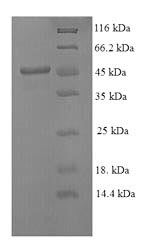Recombinant Mouse Stromelysin-1 (Mmp3) is produced in an E. coli expression system, spanning the full length of the mature protein from amino acids 104 to 477. The protein carries an N-terminal 6xHis tag, which aids in purification and detection. SDS-PAGE analysis confirms that purity levels exceed 90%. This product is designed for research use only and should not be used in diagnostic or therapeutic applications.
Stromelysin-1, also known as Mmp3, belongs to the matrix metalloproteinase (MMP) family. It appears to play a crucial role in breaking down extracellular matrix components, a process that seems vital for tissue remodeling and repair. Mmp3 participates in various physiological processes, including embryonic development, reproduction, and tissue resorption. Research suggests its activity may be particularly significant in studies of cancer, arthritis, and cardiovascular diseases, likely due to its involvement in matrix remodeling and cell signaling pathways.
Potential Applications
Note: The applications listed below are based on what we know about this protein's biological functions, published research, and experience from experts in the field. However, we haven't fully tested all of these applications ourselves yet. We'd recommend running some preliminary tests first to make sure they work for your specific research goals.
Based on the provided information, recombinant mouse MMP3 is produced in an E. coli expression system as the full-length mature protein (104-477aa) with an N-terminal 6xHis-tag. MMP3 is a zinc-dependent matrix metalloproteinase that requires precise folding, disulfide bond formation, and propeptide processing for its proteolytic activity. E. coli, as a prokaryotic system, lacks the oxidative environment for correct disulfide bond formation and may not properly incorporate zinc ions, which are essential for enzymatic activity. The His-tag may sterically interfere with the protein's active site or folding. Purity >90% by SDS-PAGE is determined under denaturing conditions and does not confirm native folding or bioactivity. No validation data (e.g., enzymatic activity assays, circular dichroism) are provided. Therefore, the protein's folding status and bioactivity cannot be confirmed and are likely compromised, making applications high-risk without experimental validation.
1. Matrix Metalloproteinase Enzyme Activity Studies
Enzymatic activity requires native conformation and metal cofactors; misfolding renders activity assays biologically meaningless. If the recombinant MMP3 is correctly folded and properly metallated with zinc, it could be used for enzyme activity studies using fluorogenic or chromogenic substrates to characterize kinetic parameters. However, if misfolded or lacking metal ions (highly probable in E. coli), activity assays would yield invalid results, as the enzyme would be inactive. The His-tag may also hinder substrate access to the active site, even with correct folding.
2. Protein-Protein Interaction Analysis
Protein-protein interactions depend on native structure; misfolding can cause artifactual binding. If properly folded, the His-tagged MMP3 could be used in pull-down assays to identify interaction partners, as the tag facilitates immobilization. However, if misfolded, interaction domains may be altered, leading to non-specific binding or failure to recognize genuine biological partners, compromising the validity of interaction networks.
3. Antibody Development and Validation
Antibodies can be produced against linear sequences, but conformational epitopes may be misrepresented if the protein is misfolded. This application is suitable as antibody generation primarily relies on linear epitope recognition, which is independent of folding status. The high purity and defined sequence support effective immunization. However, antibodies generated against a misfolded protein may not optimally recognize conformation-dependent epitopes of native MMP3 in biological contexts.
4. Structural and Biophysical Characterization
Structural studies require native folding; misfolded proteins provide inaccurate structural insights. If correctly folded, the recombinant MMP3 could be used for structural studies, but the His-tag may interfere with crystallization or NMR analysis and should be removed. If misfolded, structural data would misrepresent the native protein's architecture, leading to erroneous conclusions about MMP3's structure-function relationships.
Final Recommendation & Action Plan
Before employing this recombinant MMP3 in any application, it is essential to validate its folding and bioactivity through enzymatic assays (e.g., using fluorogenic substrates to confirm proteolytic activity) and biophysical characterization (e.g., circular dichroism for secondary structure, zinc content analysis). If validation fails, consider using eukaryotic expression systems (e.g., mammalian or insect cells) for proper folding and metallation, or obtain a commercially active MMP3 standard. For immediate use, proceed with caution for antibody development but avoid functional studies until proper folding is confirmed, and always include appropriate controls (e.g., active enzyme controls) in experiments to ensure reliability.






